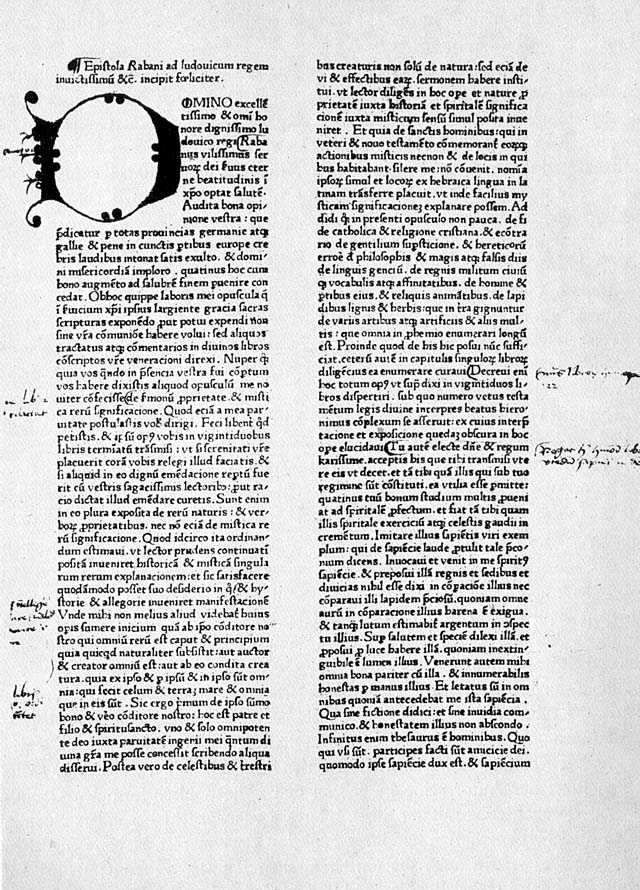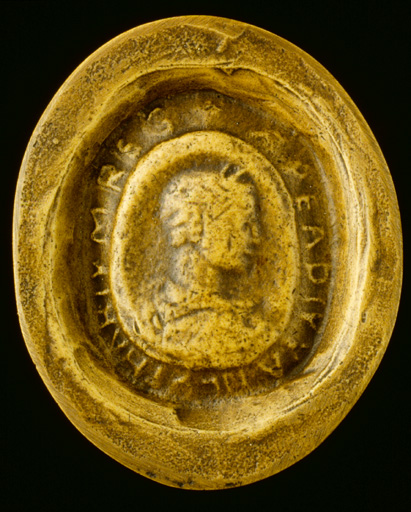|
De Procinctu Romanae Miliciae
''De procinctu romanae miliciae'' (On the Training of the Roman Army) is a short Latin treatise on the Roman army written by Hrabanus Maurus for the Frankish king Lothair II in 855 or 856. It is an epitome of an epitome, being based on the ''Epitoma rei militaris'' of Flavius Vegetius Renatus from around the year 400. The purpose of the work—whether is was practical and to what extent the selection of material reflects the realities of the Frankish army— is a matter of debate. Hrabanus must have written ''De procinctu'' after 29 September 855, when Lothair I divided his kingdom of Middle Francia among his sons, and before his own death on 4 February 856. Content After a brief prologue, ''De procinctu'' is divided into fifteen numbered and titled chapters. The quotations from Vegetius are taken entirely from sixteen chapters of the first book of the ''Epitoma'' and two chapters of the second book. ''De procinctu'' rarely retains the exact wording of its source. The information ... [...More Info...] [...Related Items...] OR: [Wikipedia] [Google] [Baidu] |
Latin
Latin ( or ) is a classical language belonging to the Italic languages, Italic branch of the Indo-European languages. Latin was originally spoken by the Latins (Italic tribe), Latins in Latium (now known as Lazio), the lower Tiber area around Rome, Italy. Through the expansion of the Roman Republic, it became the dominant language in the Italian Peninsula and subsequently throughout the Roman Empire. It has greatly influenced many languages, Latin influence in English, including English, having contributed List of Latin words with English derivatives, many words to the English lexicon, particularly after the Christianity in Anglo-Saxon England, Christianization of the Anglo-Saxons and the Norman Conquest. Latin Root (linguistics), roots appear frequently in the technical vocabulary used by fields such as theology, List of Latin and Greek words commonly used in systematic names, the sciences, List of medical roots, suffixes and prefixes, medicine, and List of Latin legal terms ... [...More Info...] [...Related Items...] OR: [Wikipedia] [Google] [Baidu] |
Roman Army
The Roman army () served ancient Rome and the Roman people, enduring through the Roman Kingdom (753–509 BC), the Roman Republic (509–27 BC), and the Roman Empire (27 BC–AD 1453), including the Western Roman Empire (collapsed Fall of the Western Roman Empire, AD 476/480) and the Byzantine Empire, Eastern Roman Empire (collapsed Fall of Constantinople, AD 1453). It is thus a term that broadly spans approximately 2,206 years, during which the force underwent numerous permutations in Size of the Roman army, size, Military of ancient Rome, composition, Structural history of the Roman military, organization, Roman military equipment, equipment and Strategy of the Roman military, tactics, while conserving a core of lasting traditions. Early Roman army (c. 550 – c. 300 BC) Until , there was no "national" Roman army, but a series of clan-based war-bands which only coalesced into a united force in periods of serious external threat. Around 550 BC, during the period conventiona ... [...More Info...] [...Related Items...] OR: [Wikipedia] [Google] [Baidu] |
Hrabanus Maurus
Rabanus Maurus Magnentius ( 780 – 4 February 856), also known as Hrabanus or Rhabanus, was a Frankish Benedictine monk, theologian, poet, encyclopedist and military writer who became archbishop of Mainz in East Francia. He was the author of the encyclopaedia ''De rerum naturis'' (''"On the Natures of Things"''). He also wrote treatises on education and grammar and commentaries on the Bible. He was one of the most prominent teachers and writers of the Carolingian age, and was called "Praeceptor Germaniae", or "the teacher of Germany". In the most recent edition of the Roman Martyrology ('' Martyrologium Romanum'', 2004, pp. 133), his feast is given as 4 February and he is qualified as a Saint ('sanctus'). Life Rabanus was born of noble parents in Mainz. The date of his birth remains uncertain, but in 801 he was ordained a deacon at Benedictine Abbey of Fulda in Hesse, where he had been sent to school and had become a monk. At the insistence of Ratgar, his abbot, he went ... [...More Info...] [...Related Items...] OR: [Wikipedia] [Google] [Baidu] |
Lothair II
Lothair II (835 – 8 August 869) was a Carolingian king and ruler of northern parts of Middle Francia, that came to be known as Lotharingia, reigning there from 855 until his death in 869. He also ruled over Burgundy, holding from 855 just the Upper regions, and from 863 also the Lower Burgundy. He was the second son of Emperor Lothair I and Ermengarde of Tours. He was married to Teutberga (died 875), daughter of Boso the Elder. Reign For political reasons, his father made him marry Teutberga in 855. Just a few days before his death in late autumn of 855, Emperor Lothair I divided his realm of Middle Francia among his three sons, a partition known as Treaty of Prüm. Lothair II received the Middle Francia territory west of the Rhine stretching from the North Sea to the Jura Mountains. It became known as ''Regnum Lotharii'' and early in the 10th century as Lotharingia or Lorraine (a designation subsequently applied only to the Duchy of Lorraine). His elder brother Loui ... [...More Info...] [...Related Items...] OR: [Wikipedia] [Google] [Baidu] |
Flavius Vegetius Renatus
Publius (or Flavius) Vegetius Renatus, known as Vegetius (), was a writer of the Later Roman Empire (late 4th century). Nothing is known of his life or station beyond what is contained in his two surviving works: ''Epitoma rei militaris'' (also referred to as '' De re militari''), and the lesser-known ''Digesta Artis Mulomedicinae'', a guide to veterinary medicine. He identifies himself in the opening of his work ''Epitoma rei militaris'' as a Christian. Dating of work The latest event alluded to in his ''Epitoma rei militaris'' is the death of the Emperor Gratian (383); the earliest attestation of the work is a ''subscriptio'' by Flavius Eutropius, writing in Constantinople in 450, which appears in one of two families of manuscripts, suggesting that a division of the manuscript tradition had already occurred. Despite Eutropius' location in Constantinople, the scholarly consensus is that Vegetius wrote in the Western Roman Empire.Walter Goffart. "The date and purposes of Vegetius ... [...More Info...] [...Related Items...] OR: [Wikipedia] [Google] [Baidu] |
Lothair I
Lothair I (9th. C. Frankish: ''Ludher'' and Medieval Latin: ''Lodharius''; Dutch and Medieval Latin: ''Lotharius''; German: ''Lothar''; French: ''Lothaire''; Italian: ''Lotario''; 795 – 29 September 855) was a 9th-century emperor of the Carolingian empire (817–855, with his father until 840) and king of Italy (818–855) and Middle Francia (843–855). Lothair I was the eldest son of the Carolingian emperor Louis I and his wife Ermengarde of Hesbaye, daughter of Ingerman the duke of Hesbaye. On several occasions, Lothair led his full-brothers Pepin I of Aquitaine and Louis the German in revolt against their father to protest against attempts to make their half-brother Charles the Bald a co-heir to the Frankish domains. Upon the father's death, Charles and Louis joined forces against Lothair in a three-year dynastic war (840–843). The struggles between the brothers led directly to the breakup of the Frankish Empire assembled by their grandfather Charlemagne, ... [...More Info...] [...Related Items...] OR: [Wikipedia] [Google] [Baidu] |
Middle Francia
Middle Francia () was a short-lived Frankish kingdom which was created in 843 by the Treaty of Verdun after an intermittent civil war between the grandsons of Charlemagne resulted in division of the united empire. Middle Francia was allocated to emperor Lothair I, the eldest son and successor of emperor Louis the Pious. His realm contained the imperial cities of Aachen (the residence of Charlemagne) and Pavia, but lacked any geographic or cultural cohesion, which prevented it from surviving and forming a nucleus of a larger state, as was the case with West Francia (which became the Kingdom of France) and East Francia (which became the Kingdom of Germany). Middle Francia was situated between the realms of East and West Francia, and comprised the Frankish territory between the rivers Rhine and Scheldt, the Frisian coast of the North Sea, the former Kingdom of Burgundy (except for a western portion, later known as ''Bourgogne'') and Provence, as well as parts of northern Italy. ... [...More Info...] [...Related Items...] OR: [Wikipedia] [Google] [Baidu] |
Trier
Trier ( , ; ), formerly and traditionally known in English as Trèves ( , ) and Triers (see also Names of Trier in different languages, names in other languages), is a city on the banks of the Moselle (river), Moselle in Germany. It lies in a valley between low vine-covered hills of red sandstone in the west of the state of Rhineland-Palatinate, near the border with Luxembourg and within the important Mosel (wine region), Moselle wine region. Founded by the Ancient Romans, Romans in the late 1st century BC as ''Augusta Treverorum'' ("The City of Augustus among the Treveri"), Trier is considered Germany's oldest city. It is also the oldest cathedral, seat of a bishop north of the Alps. Trier was one of the four capitals of the Roman Empire during the Tetrarchy period in the late 3rd and early 4th centuries. In the Middle Ages, the archbishop-elector of Trier was an important prince of the Church who controlled land from the French border to the Rhine. The archbishop-elector of Tr ... [...More Info...] [...Related Items...] OR: [Wikipedia] [Google] [Baidu] |
Planctus De Obitu Karoli
The ''Planctus (de obitu) Karoli'' ("Lament n the Deathof Charlemagne"), also known by its incipit ''A solis ortu'' (''usque ad occidua'') ("From the rising of the sun o the setting), is an anonymous medieval Latin '' planctus'' eulogising Charlemagne, written in accented verse by a monk of Bobbio shortly after his subject's death in 814. It is generally considered the earliest surviving ''planctus'', though its melody is written in tenth-century neumes, one of the earliest surviving examples of this sort of musical notation. The poem has been translated into English by Peter Godman. The authorship of the ''Planctus'' has been a matter of some dispute. Its author has been identified with Columbanus of Saint Trond, who, it is claimed, also wrote the '' Ad Fidolium'', a set of quantitative adonics. The ''Planctus'' appeared in a seventeenth-century manuscript compilation of the poems of Hrabanus Maurus under the subscription "Hymnus Columbani ad Andream episcopum de obitu Caroli ... [...More Info...] [...Related Items...] OR: [Wikipedia] [Google] [Baidu] |
Ernst Dümmler
Ernst Ludwig Dümmler (2 January 183011 September 1902) was a German historian. Biography Ernst Ludwig was born in Berlin, the son of Ferdinand Dümmler, a Berlin bookseller. He studied law, classical philology and history, among other things, at Bonn under Johann Wilhelm Löbell, and in Berlin, where his influences were Leopold von Ranke and Wilhelm Wattenbach. His doctorate dissertation, ''De Arnulfo Francorum rege'' (Berlin, 1852), was a notable essay among historians. He entered the faculty at Halle in 1855, and started an historical seminar. In 1858 he became an associate professor, in 1866 full professor. In 1875, he became a member of the revised committee directing the ''Monumenta Germaniae Historica'', himself undertaking the direction of the section "Antiquitates". In 1888 he became president of the central board in Berlin. This was an official recognition of Dümmler's leading position among German historians. Selected works In addition to numerous critical wor ... [...More Info...] [...Related Items...] OR: [Wikipedia] [Google] [Baidu] |




